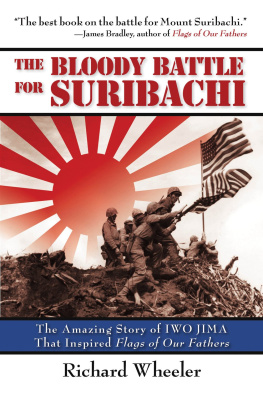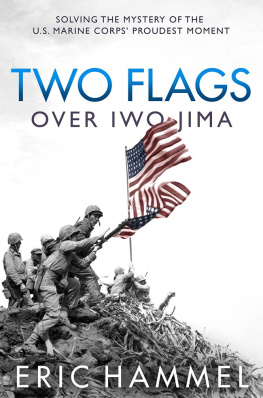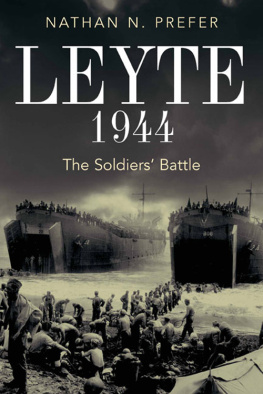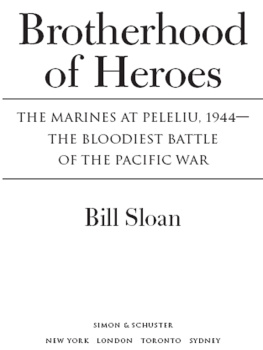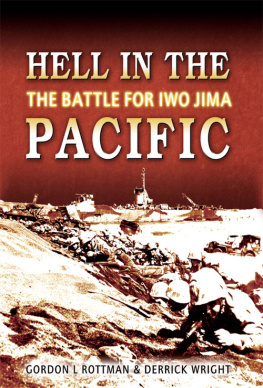
Other books by Richard Wheeler
Shermans March
The Siege of Vicksburg
Voices of the Civil War
Voices of 1776

To my sister
Margery Wheeler Mattox
who lived through the home-front adventures
The latest edition of the work has been brought to publication with the generous assistance of Marguerite and Gerry Lenfest.
Naval Institute Press
291 Wood Road
Annapolis, MD 21402
1980 by Richard Wheeler
All rights reserved. No part of this book may be reproduced without written permission from the publisher.
Originally published by Lippincott & Crowell, Publishers.
First Bluejacket Books printing, 1994
ISBN 978-1-61251-440-6 (eBook)
The Library of Congress has cataloged the paperback edition as follows:
Wheeler, Richard.
Iwo.
Bibliography: p.
Includes index.
1. Iwo Jima, Battle of, 1945. I. Title.
D767.99.I9W52 940.5426 79-25120
Designed by Ginger Legato

 Print editions meet the requirements of ANSI/NISO z39.48-1992 (Permanence of Paper).
Print editions meet the requirements of ANSI/NISO z39.48-1992 (Permanence of Paper).
10 9 8 7 6
CONTENTS
I served with the Marines on Iwo Jima, being an enlisted man with a rifle, a member of the company that raised the flag on Mount Suribachi, and one of the battles more serious casualties. For the most part, I have kept myself out of the book. This is not a personal account but the story of Iwo Jima. However, considerable attention has been given to my Easy Company comrades, whose unique and especially dramatic role in the struggle resulted in the most famous combat photograph ever taken and inspired one of the largest bronze statues ever cast.
Much of the material in the book came directly from participants in the assault, many veterans responding to my request for information. Some gave it in interviews, others provided cassettes, and still others went to the trouble of writing long memoirs. These obliging men also made available letters they had written home, maps used on the battlefield, reports, unit rosters, casualty lists, newspaper clippings, and other items they had saved through the years. I am deeply grateful to all of these veterans and want to offer a special thanks to four who went above and beyond the call of duty: Colonel Dave E. Severance, Arthur J. Stanton, Frank L. Crowe, and Robert D. Sinclair.
Some very useful contacts with participants were arranged by Virginia K. Stassen, ever a booster of the 5th Marine Division. And valuable aid with both research and correspondence was given by my longtime friend and assistant Kathleen Bross, who was also a constant source of support and encouragement.
Frequently consulted for the purpose of gleaning the Japanese side of the story was the manuscript account Fighting Spirit: Iwo Jima, by Major Yoshitaka Horie of General Tadamichi Kuribayashis staff. Also especially helpful was the material from Japanese sources used in publications by the Historical Division, Marine Corps Headquarters, and the books Iwo Jima by Richard Newcomb and The Rising Sun by John Toland.
The majority of the illustrations are official Marine Corps and Navy photographs, many of them obtained from the History and Museums Division of Marine Corps Headquarters. Others were provided by Louis R. Lowery, who took them while serving as a photographer for Leatherneck magazine. Major Horie supplied those from Japan, securing the Kuribayashi items from the generals widow.
Iwo was first published in 1980, the battles thirty-fifth anniversary year. This edition is intended to help mark the fiftieth.



It was the dawn of February 19, 1945. The waters of the western Pacific took on a silvery shimmer, and Iwo Jima was revealed to the Marines of the 5th Amphibious Corpsstanding in full combat gear on the weather decks of their transportsas a gray silhouette with faint green tracings. The Marines were several miles east of the Japanese island, and this was their first view of it, their transports having eased up during the night and merged with the great assemblage of warships that had been bombarding the enemys defenses for the past seventy-two hours.
It was D day, and the bombardments pre-H-hour phase was opening. H hour, the time the first wave would hit the beach, was nine oclock. The big guns of the battleships and cruisers flashed a vivid orange as they boomed their projectiles toward their assigned target areas. Also in action were rocket ships whose missiles left long white backblasts as they whooshed from their launchers. Destroyers, destroyer escorts, and mortar ships were moving into positions from which their weight could be added to the effort. Spotter planes wheeled overhead. The island sparkled with shellbursts, and a steady rumble issued back across the water. Smoke and dust billowed skyward.
A formation of heavy bombers from an Army base in the Marianas Islands was droning its way toward Iwo, its object to deliver a last-minute strike at an altitude of about 5,000 feet. And roaring from the decks of carriers in the waters about a hundred miles northwest of the island came Navy and Marine fighters and bombers equipped to assail the enemy with bullets, rockets, and napalm.
Iwos defenders did not reply with fire of their own, but waited out the bombardment huddled in the dim light of an elaborate system of blockhouses, bunkers, pillboxes, caves, tunnels, and underground rooms. Many of the men tried to shut out the noise by covering their ears with their hands. The island trembled as though in the grip of a major earthquake. Bits of concrete, volcanic rock, and dirt were shaken from shadowy ceilings and came pattering down on anxious heads. In sandy areas on Iwo, new craters were blasted in rapid succession, while those areas made up chiefly of craggy rocks underwent radical topographical changes. The sparse green brushwood was slashed and splintered. Direct hits collapsed cave entrances and damaged bunkers and pillboxes. But thousands of defenses remained fully operational, and the great majority of the defenders were unharmed.
Next page

